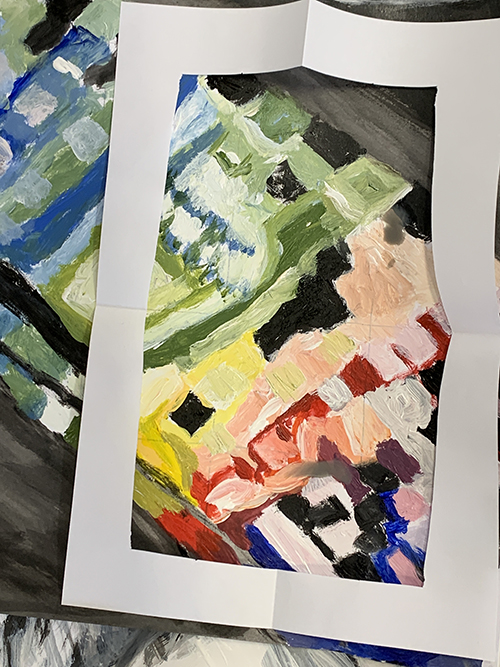As an artist, I’ve always been interested in color and its impact on a piece of art. In the last six months, I’ve been particularly focused on learning more about color theory and experimenting with different techniques for mixing colors in acrylic paints. This experience has taught me so much and has greatly enhanced my enjoyment of art.
Previously, I had a basic understanding of color theory and would often rely on pre-mixed colors when working with acrylic paints. I knew about the primary colors and how they could be combined to create secondary and tertiary colors, but I didn’t have a deep understanding of the nuances and complexities of color mixing.
In the last 6 months
In the last six months, I’ve delved deeper into the world of color theory and have learned a lot about how to mix colors in acrylic paints to achieve a wide range of shades and hues. I’ve experimented with different techniques, such as using complementary colors to create rich, vibrant tones and using a limited color palette to create cohesive, harmonious compositions. I’ve also learned about the various factors that can affect the appearance of colors, such as the type of surface being painted on and the lighting conditions.
One of the biggest challenges I faced in my journey to learn more about color theory was overcoming my fear of making mistakes. I would often be hesitant to mix colors because I didn’t want to ruin a piece of art by creating a color that didn’t look right. However, I quickly realized that making mistakes is an important part of the learning process, and that the only way to truly improve my skills was to experiment and try new things. I started to embrace the uncertainty and became more willing to take risks in my art, which has been incredibly rewarding.
One of the most exciting aspects of learning more about color theory and mixing colors in acrylic paints has been the impact it has had on my art. I’ve been able to create more vibrant, dynamic pieces that are full of life and energy. I’ve also been able to use color to create mood and atmosphere in my art, which has been a great learning experience. I’ve received a lot of positive feedback from others about the improvements in my art, which has been very encouraging.
One of the pieces of art that I’m particularly proud of is a landscape painting that I created using my new knowledge of color theory. I started by selecting a limited color palette of three primary colors, plus black and white, and used these colors to mix all of the shades and hues in the painting. I paid careful attention to the relationships between colors, using complementary colors to create contrast and harmony. The result was a vibrant, lively painting that captures the beauty and majesty of the landscape.
In conclusion, learning more about color theory and experimenting with color mixing in acrylic paints has been a wonderful experience that has greatly enhanced my enjoyment of art. I’ve gained a deeper understanding of color and how it can be used to create beautiful, expressive pieces of art. I’m excited to continue exploring this fascinating topic and to see how it will continue to influence my artistic practice.
Overall, my experience with color theory and acrylic painting has been incredibly rewarding and has helped me to become a better artist. I’ve learned a lot about the technical aspects of color mixing, as well as the creative possibilities that it offers. I’m excited to continue exploring and experimenting with color in my art, and to see where it will take me in the future.
In the coming months, I plan to continue learning more about color theory and to expand my knowledge of color mixing techniques. I’m also looking forward to applying what I’ve learned to new and exciting projects and to see how my art will evolve and improve over time.
In summary, my experience with color theory and acrylic painting has been a journey of discovery and growth. It has helped me to develop new skills and to see the world in a new, more colourful way. I’m grateful for the opportunity to learn more about color and to apply it in my art, and I’m excited to continue exploring this fascinating topic in the future. In addition to the personal benefits that I’ve gained from learning more about color theory and acrylic painting, I believe that this knowledge has also made me a more well-rounded and versatile artist. By understanding the technical aspects of color mixing, I’m able to create a wider range of colors and shades, which allows me to experiment with different styles and techniques. This has made me more confident in my art and has given me the freedom to try new things and push the boundaries of my creativity.
Furthermore, my improved understanding of color theory has also made me more aware of the emotional and psychological effects of color. I’ve learned how different colors can evoke different moods and feelings, and how they can be used to convey a specific message or theme in a piece of art. This has given me a new level of control and intentionality in my art, and has helped me to create pieces that are more impactful and meaningful.
Overall, my experience with color theory and acrylic painting has been incredibly rewarding and has enriched my artistic practice in many ways. I’m grateful for the opportunity to learn more about color and to apply it in my art, and I’m excited to continue exploring this fascinating topic in the future.
Signed
Roxks




